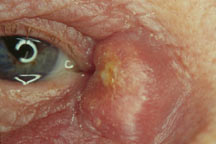|
| |
Dacryocystitis
Dacryocystitis is an infection of
the tear sac that lies between the inner corner of the eyelids and the
nose. It usually results from blockage of the duct that carries tears
from the tear sac to the nose. The blocked duct harbors bacteria and
becomes infected. Dacryocystitis may be acute (sudden onset) or chronic
(frequently recurs). It may be related to a malformation of the tear
duct, injury, eye infection, or trauma.

This problem is most
common in infants because their tear ducts are often underdeveloped and
clog easily. Babies often have recurrent episodes of infection; however,
in most cases, the problem resolves as the child grows. In adults, the
infection may originate from an injury or inflammation of the nasal
passages. In many cases, however, the cause is unknown.
SIGNS AND
SYMPTOMS
•Generally affects one eye
•Excessive tearing
•Tenderness, redness, and swelling
•Discharge
•Red, inflamed bump
on the inner corner of the lower lid
DETECTION AND DIAGNOSIS
During the exam, the doctor will determine the extent of the blockage.
Cultures may be taken of the discharge to identify the type of
infection. The doctor will also determine whether the infection has
affected the eye.
TREATMENT
The treatment for dacryocystitis
is dependent on the person's age, whether the problem is chronic or
acute, and the cause of the infection.
Infants are usually
treated first by gently massaging the area between the eye and nose to
help open the obstruction along with antibiotic drops or ointments for
the infection. Surgery may be necessary to clear the obstruction if
medical treatment is not effective and the problem persists over several
months.
Before surgery, the doctor may treat the child with
antibiotics to make sure the infection is cleared. The operation is
performed under general anesthesia. The tear duct is gently probed to
open the passage.
For adults, the doctor may clear the
obstruction by irrigating the tear duct with saline. Surgery is
sometimes necessary for adults if irrigation, or antibiotics fail to
resolve the infection or if the infection becomes chronic. In these
cases, dacryocystorhinostomy (DCR) is performed under general anesthesia
to create a new passage for the tear flow.
|
|